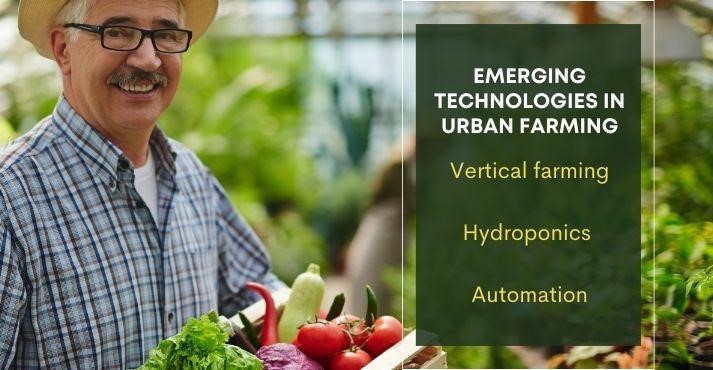Urban farming is a relatively new phenomenon. It is redefining the traditional model of rural farming to an innovative, sustainable approach to food production within cities.
Whether through community gardens, rooftop farming, or vertical farming, urban agriculture is changing the farm-to-table approach, bridging the divide between the city and nature in Southeast Asia.
Urban farming in Southeast Asia is playing a vital role in sustainable food production. It is helping the region to reduce transportation emissions, conserve lands, foster community resilience, and promote fresh, local produce, ensuring a more environmentally friendly and food-secure future.
As we navigate through the Southeast Asia region, urban farms in Singapore have gained prominence for growing food within city environments.
Let’s start analyzing the urban farming landscape in Southeast Asia.
The Need for Urban Farming in Southeast Asia
More than half of the world’s population lives in urban areas. According to the new United Nations report, by 2050, two out of every three people will likely live in cities or other urban centers, highlighting the need for more sustainable urban planning and public services.
Hence, to combat food insecurity as rapid urbanization occurs, the urban revolution in East Asia will ensure a local, sustainable food supply, conserving resources and promoting resilience in the face of climate change and urban expansion.
Food manufacturers also turning to urban farming for fresher ingredients, shorter supply chains, reduced environmental impact, and to meet increased consumer demand.
According to the World Economic Forum, Singapore aims to produce 30% of its food by 2030. Only 1% of Singapore’s land is being used for conventional farming.
Singapore is focusing on growing more with less; with the government’s support, the establishment of multi-story vegetable farms and recirculating aquaculture systems that can produce 10 to 15 times more than conventional farms are drastically being developed.
Challenges of Urban Farming in Southeast Asia

Urban farmers in Southeast Asia face various challenges and barriers, such as land scarcity, air and soil pollution, water access, zoning regulations, climate change, pests and diseases, market access, economic viability, infrastructure, and growing competition.
According to the National Library Board of Singapore, Singapore is considered one of the most water-stressed countries in the world, as it is heavily dependent on rainfall due to the lack of natural water resources and limited water storage facilities.
Rapid urbanization and rising temperatures make access to natural water sources increasingly complex in Singapore.
Therefore, as per the data published by the International Water Association, Singapore has built a robust and diversified water supply from NEWater (high-grade reclaimed water) and desalinated water to meet the growing demand.
Singapore is the world’s third most densely populated territory, with less than one percent of its land used for agriculture. Therefore, even with improvements in agriculture technology, it would be difficult for Singapore to achieve its goal of producing maximum food.
Despite challenges like space constraints and soil contamination, solutions and Agritech innovations continue to emerge, making East Asia urban agriculture increasingly viable.
Emerging Technologies in Urban Farming

The utilization of technology in the development of modern-day agriculture is transforming Southeast Asian urban farming. Foodtech and Agritech are helping farmers maximize yields by integrating data analytics, machine learning, artificial intelligence, and robotics.
Moreover, urban gardening in Southeast Asia is a revolutionary new trend transforming how we think about agriculture.
Here are some of the critical advancements in urban farming, increasingly being adopted by manufacturers of food:
- Vertical farming: Vertical farming is revolutionizing urban farming by optimizing space, enabling crops to be cultivated in stacked layers, and reducing land requirements.
- Hydroponics: Farmers are adopting hydroponics as an innovation to promote efficient plant growth without soil through lighting technologies.
- Automation: Automation with the integration of IoT devices and robotics is helping urban farmers monitor and control environmental conditions, manage irrigation, and even harvest crops.
These technological strides enhance productivity, reduce resource consumption, and contribute to sustainable, year-round food production, addressing the challenges of urbanization, climate change, and food security.
For example, manufacturers like Grobrix are unlocking opportunities in Asia’s F&B market by revolutionizing urban farming with its innovative soil-less indoor system, combining the visual appeal of a green wall with the practicality of controlled environment agriculture.
Thus enabling fresh, locally cultivated produce within a shelf-like setup that offers the essential light and water for a thriving small garden of leafy greens, herbs, and fruit-bearing plants.

Source: Grobix
With just 1% of Singapore’s land set aside for farming, Singapore’s farms use indoor multi-story LED lighting and recirculating aquaculture systems to produce 10 to 15 times more than traditional farms.
According to SFA (Singapore Food Agency), Singapore is working towards its 30 by 30 food security goal to transform the farming landscape and make it more productive, climate-resilient, and sustainable.
Government Initiatives and Policies
Owing to demographic shifts and overall population growth, the government supports urban agriculture in East Asia by supporting manufacturers and farmers.
Government initiatives and policies are crucial in facilitating zoning regulations, financial incentives, and educational programs to encourage sustainable agriculture. They also provide access to land and resources, enabling citizens to grow their food and reduce their ecological footprint.
In addition, government support for urban agriculture and farming companies to address food security and environmental challenges, promoting healthier, more self-sufficient communities.
Singapore launched the SGD30M Fund to boost local urban farms in Singapore and has been awarded close to S$40 million for the city-state’s local food production and food security.
Such initiatives contribute to the growth of urban farming, enhancing urban resilience and sustainability in the region.
According to NEA, food waste production accounts for about 12% of the total waste generated in Singapore.
Reducing food waste, redistributing unsold or excess food, and recycling/treating food waste are critical parts of the national waste management strategies to work toward Singapore becoming a Zero Waste Nation.
A New Generation of Farmers
According to BBC Future, the future of farming is not as secure as we expect, as the world’s farming population is growing older and young prefer to live near cities.
In the UK, the average age of a farmer is 59. In Kenya, it is 60. In Japan, the highest average age for a farmer is 67. However, opening farming to non-traditional young farmers means more room for growth.
The growing trend towards urban farms in Singapore presents emerging opportunities for entrepreneurs, investors, and individuals interested in urban farming.
For next-gen sustainable urban farming, avenues in vertical farming, aquaponics, and rooftop gardens need to be explored and maximized for space efficiency.
As an investor in the Southeast Asian urban sector, you can tap into the growing demand for fresh, locally sourced produce by supporting urban agriculture startups.
Moreover, as urban populations expand, individuals can seize opportunities to grow their food, reduce their carbon footprint, and generate income through small-scale urban farming.
A new generation of farmers in Southeast Asia is set to bring a paradigm shift in urban farming through technology and understanding consumer preferences.
As an emerging entrepreneur, investor, and individual, you must stay updated with the top 5 Trends in Asia’s Food and Beverage Industry for 2023 to learn about urban farming.
Urban Farming in Southeast Asia (FAQs)
What are the main challenges faced by urban farmers in Southeast Asia?
The main challenges faced by urban farmers in Southeast Asia include:
- Land availability and access
- Water scarcity and quality
- Urban pollution and contamination
- Lack of technical knowledge and resources
- Regulatory and policy constraints
Why is urban farming gaining popularity in Southeast Asia?
Urban farming is gaining popularity in Southeast Asia due to:
- Rapid urbanization instills the need for locally sourced food to feed urban populations.
- Urban farming addresses environmental concerns and reduces food miles, positively impacting agriculture.
- Urban farming provides economic opportunities through income-generating activities and promotes food security in densely populated urban areas.
Are there specific crops that thrive in Southeast Asian urban environments?
The specific crops that thrive in Southeast Asian urban environments include:
- Papaya
- Mango
- Thai basil
- Morning glory
- Lemongrass
- Kaffir lime
- Kangkong
Conclusion
South Asia, home to one-fifth of the world’s population, is reeling under the changes brought about by altering environmental conditions and the climate.
Urban Farming in Southeast Asia is transforming to address the ongoing challenges. Technological innovation is the only way to help farmers increase productivity and meet the evolving needs of the food sector.
Government support and policies have encouraged urban producers to modernize and invest in safer growing practices. Access to machines for urban farmers, well-regulated aquaculture, and improved practices can make urban agriculture in Southeast Asia more productive and sustainable.
This effort will facilitate the successful take-up of farming and encourage small-scale farmers to enter the domain.
Adaptation to urban farming is one of the keys to coping with these challenges and transforming how they grow food, considering future climate risks. With the right combination of tech, policy, and education, Southeast Asia will contribute towards fulfilling its goals.
According to estimates compiled by the Food and Agriculture Organization (FAO), the world will need 60 percent more food. Hence, there is no better time for the next wave of innovation in the agricultural sector to optimize and future-proof food security.





























